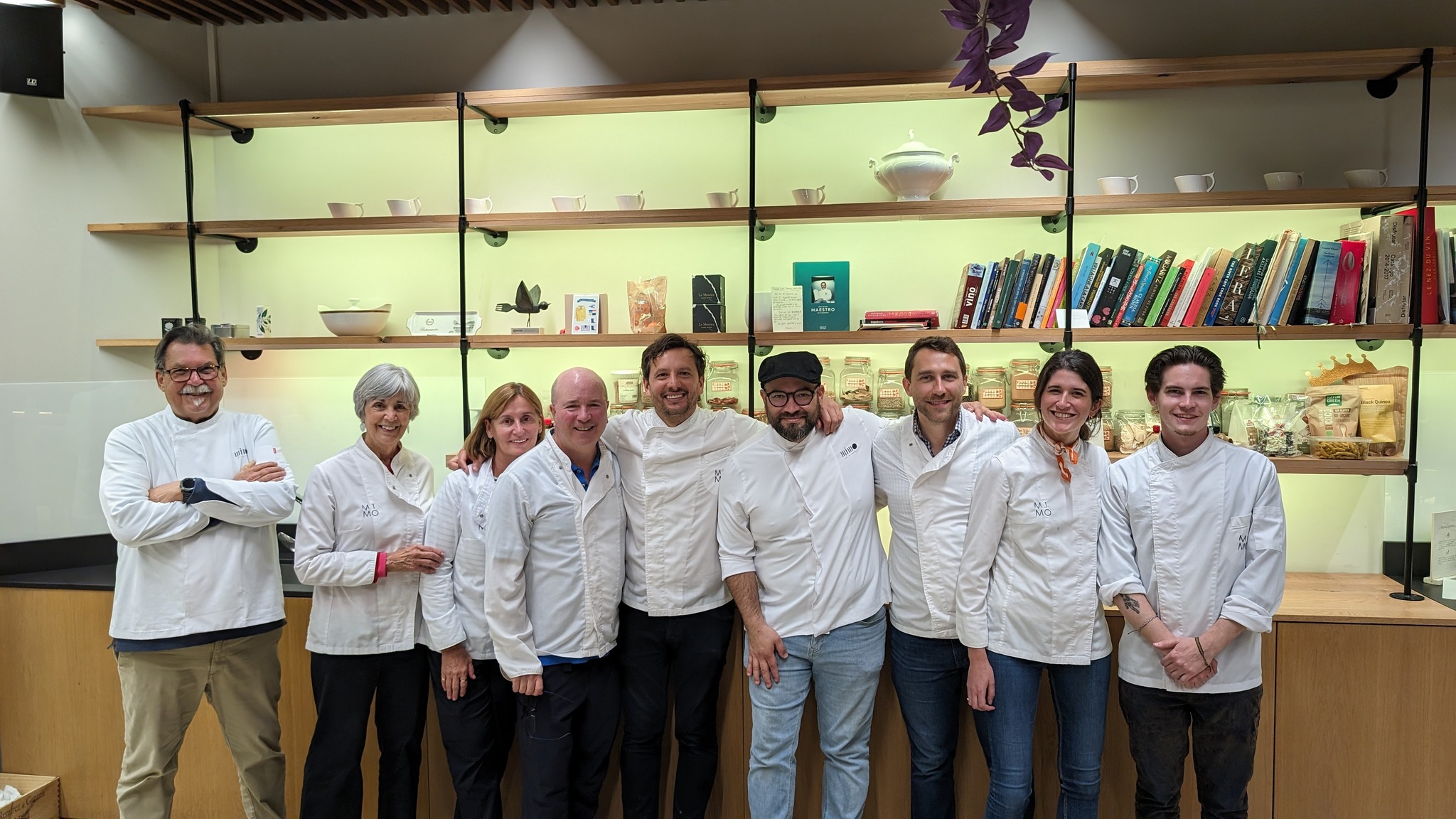Most food lovers who pintxo crawl through San Sebastian’s old town are more than satisfied sampling these legendary Basque bites. Among them, though, are a passionate few who want to take their experience to the next level – that is, learning how to cook pintxos and other Basque classics. We had the good fortune to pursue this ambition at the Market Tour and Cooking Class from Mimo Bite the Experience during our San Sebastian stay.
We’ve taken cooking classes around the world and discovered that we learn much more than new cooking skills – although that is essential. A good cooking class includes lessons in the history and cultural significance of the dishes and their ingredients. In just about every region in the world, food items have become icons of the culture. Learning about these relationships is an essential insight into the place and its people. For us, that knowledge fosters respect and makes our travel experiences richer and more memorable.
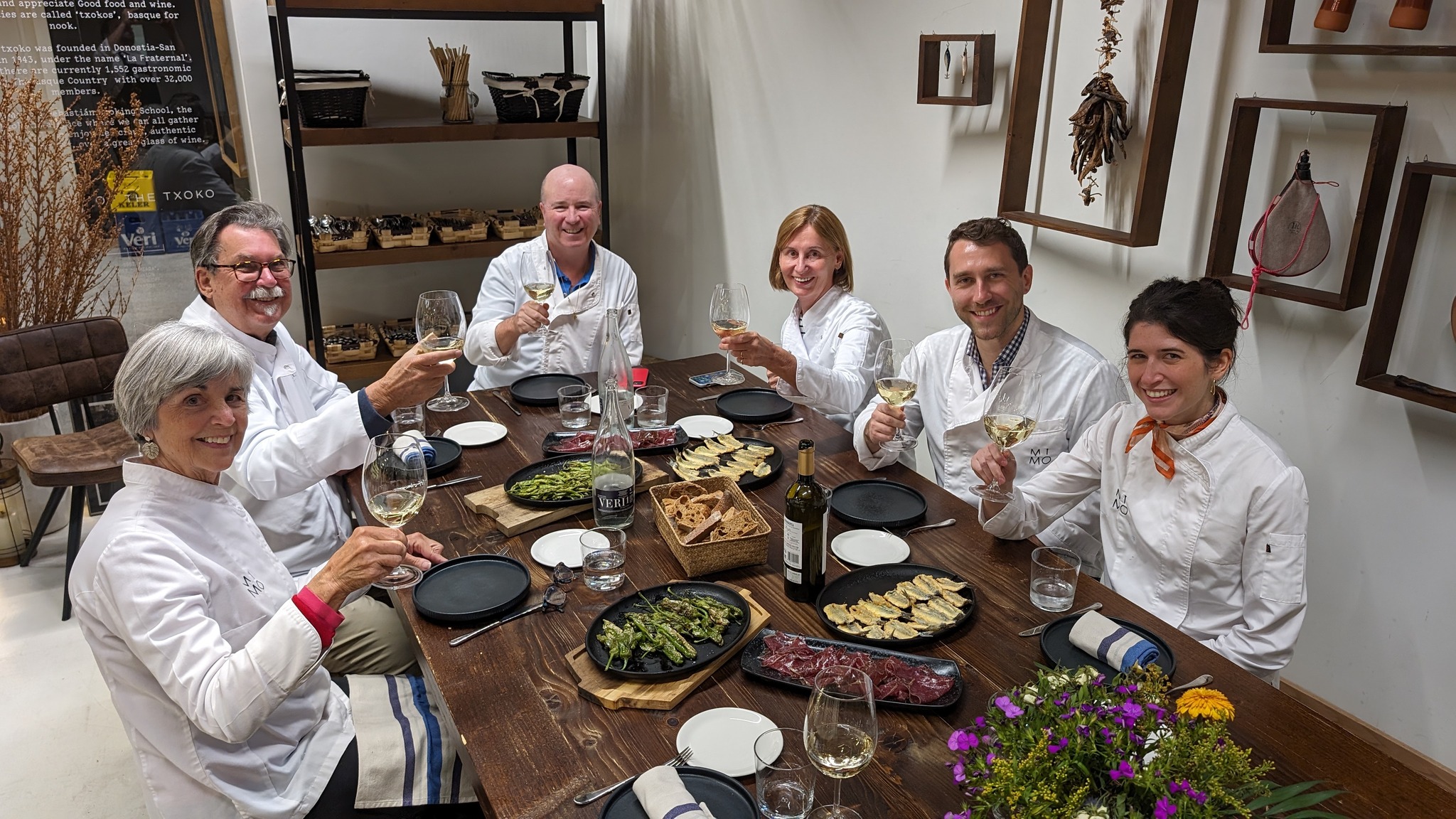
Beyond all of that, a cooking class is just a whole lot of fun – an interactive dinner party with curious like-minded travelers. Once the class dons chef whites or aprons we become a team, ready to master chef techniques while preparing and enjoying some delicious and often iconic dishes. Add a little wine and amiable professionals like Mimo’s talented chefs Patricio Fuentes, Eneko Irizar, Erick Muñoz (all Michelin-experienced), and their dedicated team and you have a perfect formula for memorable good times.
Mimo offers a variety of classes including one that prepares a typical Michelin-starred restaurant tasting menu. We selected our class hoping to learn not only some Basque dishes but also how to navigate Spain’s bustling mercados. Their shops burst with strange and wonderful items that can overwhelm visitors used to buying pre-packaged meat and fish in a supermarket.
Our small class including two other couples gathered at the impressive modern Mimo cooking complex in the Hotel Maria Cristina, one of the city’s most exclusive and historic hotels. We were greeted by Lara Ibericu, sales and events manager, who briefed us on the class schedule and introduced us to the chefs. In minutes we were off to Bretxa Market, just a few blocks away.
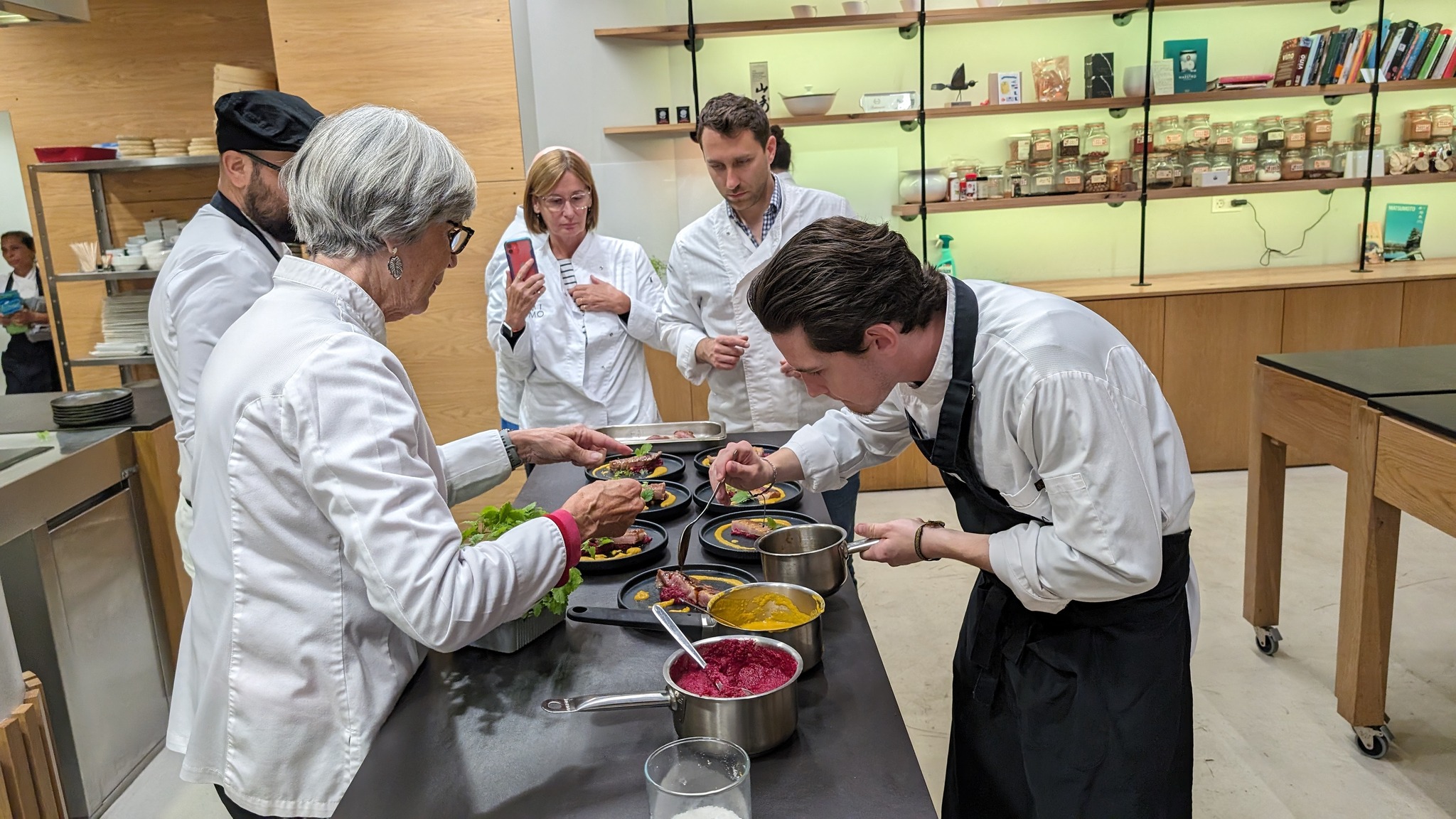
For more than a century, Bretxa has been the heart of the city’s gastronomic traditions and culinary events. Today it’s in a state of flux. The original building is now a shopping center anchored by a gigantic McDonald’s while long-stalled plans aim to turn the adjacent old fish market into one modeled after those in Madrid and Barcelona. So for now farmers sell their produce outside under awnings, while the butchers, fishmongers, and Basque specialty shops are in the basement of a relatively modern building across a small square.
The long row of farmer tables displayed mostly the same seasonal produce – today it was asparagus, peas, lettuces, etc. All were fronted by women. According to tradition here, wives sell the produce and handle the money while husbands tend the fields.
Patricio explained that he was shopping for a couple of very special items only available in the spring. He let us sample some intensely sweet tiny green peas that would star in the mushroom dish we would cook. Then he dropped a bomb. These Tear Peas, also referred to as “green caviar,” sell for up to a whopping $350 a pound.
The other key item in the dish also raised our eyebrows. From another vendor, Patrcio passed around a perfectly formed miniature mushroom, tiny like the peas. They are perretxikos, or St. George’s mushrooms, and they too, are expensive, ranging anywhere from $45 to $180 a pound. But this is Michelin country and you expect a little extravagance on a $500 per person tasting menu. Or, you might do a class like ours for a lot less, sample these gems, and have a lot more fun.
Once inside the market, our small group was divided in half. Patricio explained that Mimo had developed special relationships with its vendors and didn’t want to overwhelm them or intimidate other regulars with a large group of strangers. This concern and respect certainly pay off. The vendors were gracious and friendly as we sampled our way through the building.
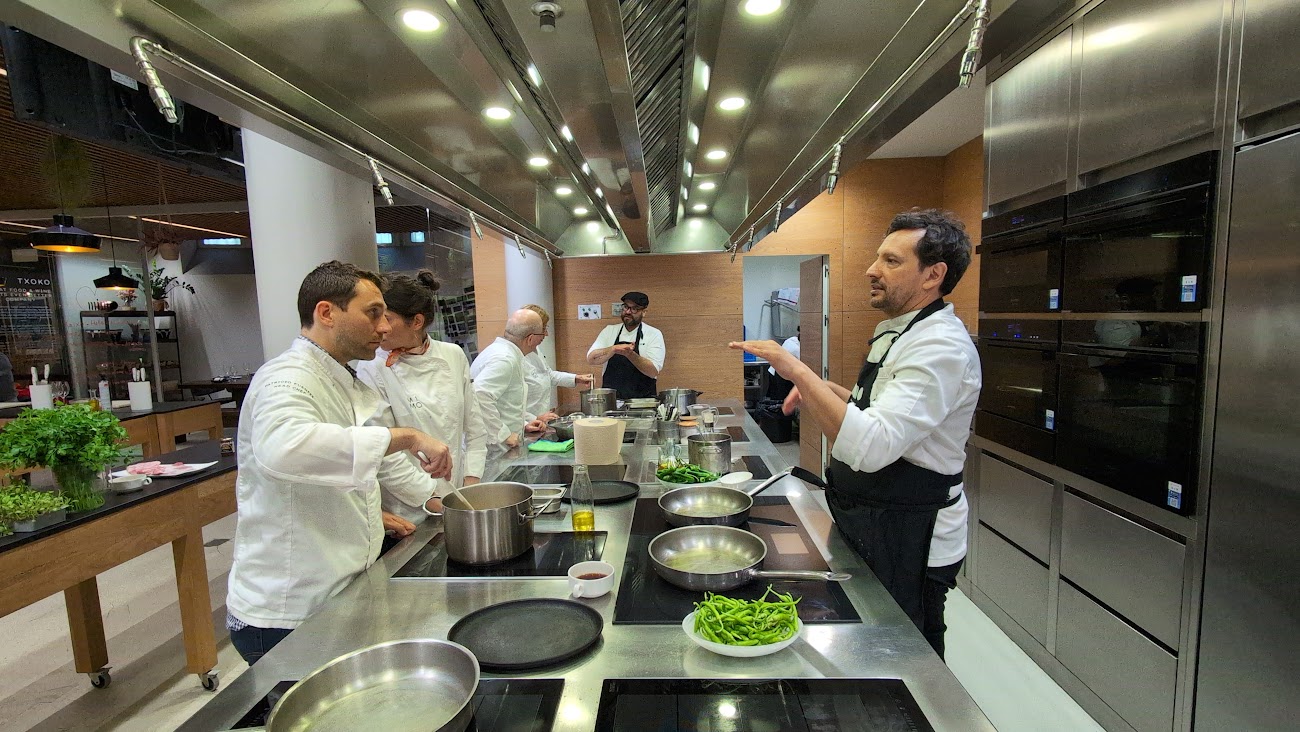
First up was a butcher that is Mimo’s main meat provider. We didn’t dare ask the cost of the just butchered pork skirt steak for our main dish. Then on to the fishmongers for fresh anchovies, where most restaurants shop for seafood. The counters were spotlessly clean and the fish ultra fresh. No fishy odors here.
A couple more market items of note. At one specialty shop for deli meats, cheeses, and the like, we sampled super thin-sized slices of cecina, dried and lightly smoked beef that melted in your mouth. We thought it was tastier than Spain’s famous jamon. We took a plate back to the school where it would be an appetizer for our class meal. At the same stall, we sampled some spicy olives of the dozens on display. And we downed the famous Gilda pintxo, skewered olives, spicy peppers, and anchovy. Tangy and delicious, this mouthful wakes up your taste buds! As per custom, I ate it all in one bite.
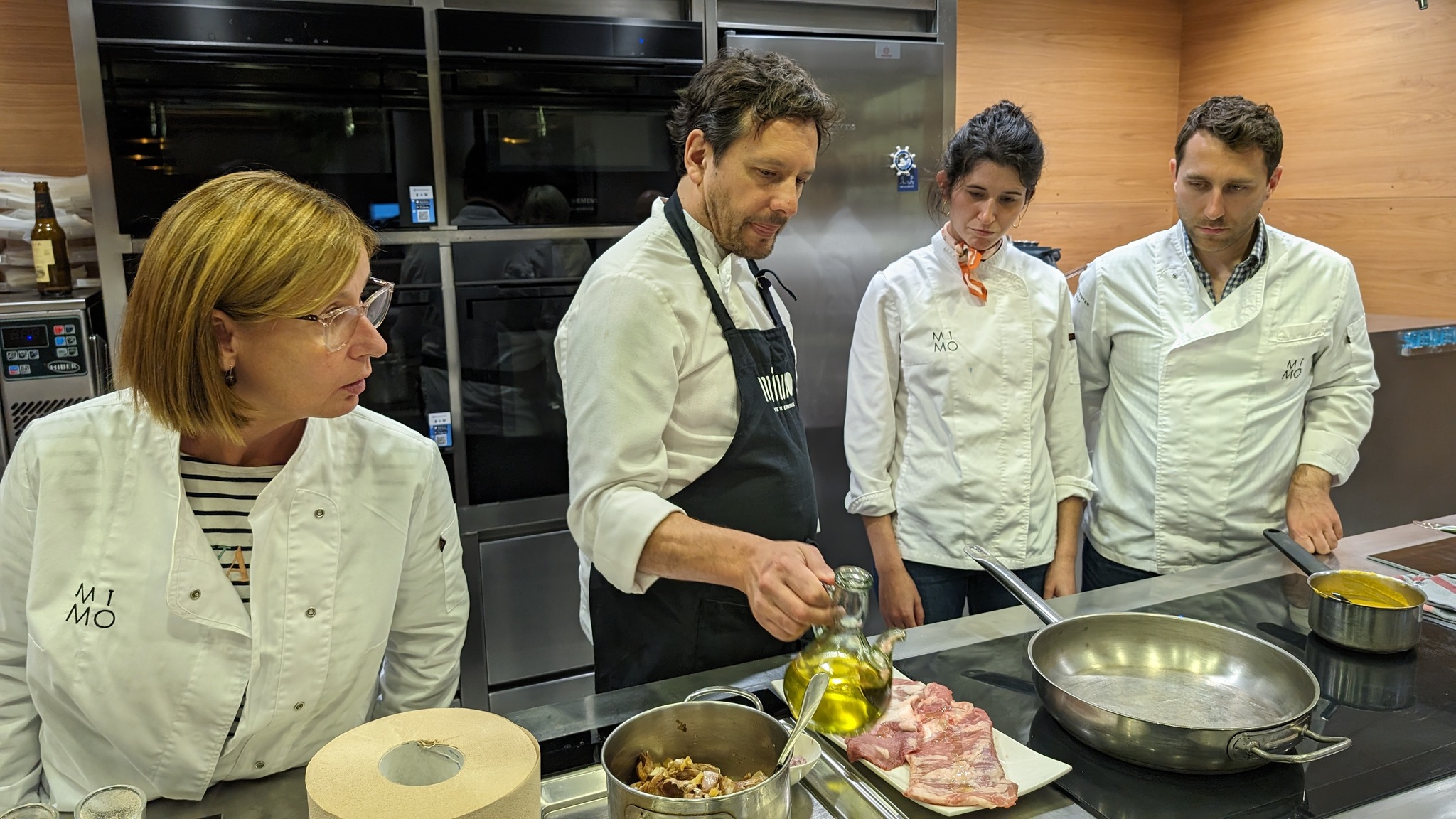
After such a rewarding visit to the market, we could only hope our classroom experience would equal it. It did indeed.
We gathered by the bar for a glass of crisp white wine and donned our professional chef’s white coats. It would be our only wine until we sat down at the chef’s table for our lunch starters. After all, we would be working in a kitchen with a lot of sharp and hot objects.
Our Mimo class was much different from most we’ve experienced. Instead of a chef demonstrating cooking techniques in front of a group of students, Mimo’s lessons were like being part of a working restaurant kitchen. Each of the chefs, along with their intern Reese, prepped dishes simultaneously, at different workstations – just as they would in a real professional kitchen. We moved among them, working and watching, as the dishes came together.
We learned how to clean fresh anchovies, slipping out their innards and backbones. Later they would be dusted with flour, dipped in egg, and fried for seconds in hot canola oil. A delicious classic starter.
We chopped onions and beets. Chef Eric pulled out a portable propane blow torch to char a large tomato, making it easy to wipe away the skin with a paper towel. Then he passed the torch to adventurous students who eagerly blackened a few more. These would be roasted and pureed for a sauce.
We also made a silky pastry cream for the dessert. Chef Eric slit open vanilla beans to release the tiny black seeds into the egg and cream mixture. Then he slipped the used beans into a jar of sugar to flavor it for other dishes. He also demonstrated how quick whisking could save a pastry cream that turned lumpy while thickening on the stove. Later we would layer it between layers of puff pastry.
All of this was a lesson in “mise en place,” standard practice in every well-run kitchen in the world. The concept is simple – to put in place all the elements needed before you cook, bake, or assemble each item on the menu. It makes for more consistent final dishes and greatly reduces stress in a fast-paced kitchen.
Most of our classwork was dedicated to gathering and preparing ingredients. As we worked, laughed, and learned, we didn’t feel like observers. No, we felt like chefs worthy of the whites we were wearing.
Blistered padron peppers are a favorite tapas we discovered in Madrid. We tried to make them at home but they never equaled the ones we enjoyed in Spain. Thanks to our Mimo class, we now know the secret of how to make them perfectly: Put them in a cold frying pan, turn on the heat, and do nothing until they start to sizzle and blister. To emphasize the need for patience and hands-off, Chef Patricio playfully took the tongs away from his students, returning them only when the peppers were ready to turn. A little salt and they were perfect.
When the peppers and anchovies were cooked and plated, we took our seat at the table to savor the starters we made. Five stars for all, everyone humbly agreed. Also on the table were platters of cecina and bread, and bottles of white wine. Conversation and wine flowed until we were summoned back to the kitchen to make the next course.
There we found a new appreciation for classic Revuelto de Hongos, garlicky mushrooms, eggs, and parsley. Sounds simple but it’s not. Patricio explained that many restaurants take shortcuts resulting in a dish of runny scrambled eggs and mushrooms – or they don’t make it at all because it takes too much time to do correctly. We took turns stirring the beaten eggs into the lightly sauteed mushrooms to meld them into the mushroom juices and create a silky sauce. The process took us almost 30 minutes.
Once plated, each serving was crowned with the lightly blanched tear peas. Back at the table, we gobbled them down. Another 5-star success that we toasted with more white wine.
Back in the kitchen, we learned another chef’s secret as Patricio cooked the pork. The meat was lightly coated with oil, but not seasoned. Instead, salt was scattered in the frying pan. The meat was seared on both sides, then sliced and put into the oven to finish cooking.
Back at the table, we tucked into our pork entree, plated with swaths of pureed roasted veggies and served with a yummy Rioja red. One last time in the kitchen to assemble the dessert and we capped our meal with the milhojas de crema – buttery sweet and palate-pleasing.
In the end, we reluctantly relinquished our chef whites. For us, our Mimo class was a culinary event as memorable as any fine dining experience. We met new friends, learned new skills, savored an outstanding meal, and had a whole lot of fun. It can’t get much better than that.
